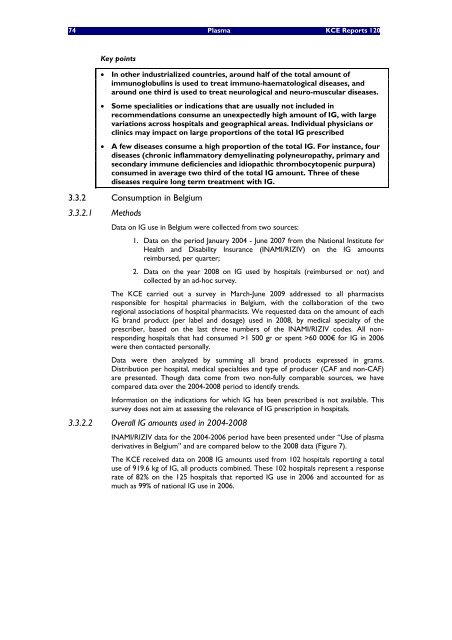The report is available in English with a French summary - KCE
The report is available in English with a French summary - KCE
The report is available in English with a French summary - KCE
You also want an ePaper? Increase the reach of your titles
YUMPU automatically turns print PDFs into web optimized ePapers that Google loves.
74 Plasma <strong>KCE</strong> Reports 120<br />
Key po<strong>in</strong>ts<br />
• In other <strong>in</strong>dustrialized countries, around half of the total amount of<br />
immunoglobul<strong>in</strong>s <strong>is</strong> used to treat immuno-haematological d<strong>is</strong>eases, and<br />
around one third <strong>is</strong> used to treat neurological and neuro-muscular d<strong>is</strong>eases.<br />
• Some specialities or <strong>in</strong>dications that are usually not <strong>in</strong>cluded <strong>in</strong><br />
recommendations consume an unexpectedly high amount of IG, <strong>with</strong> large<br />
variations across hospitals and geographical areas. Individual physicians or<br />
cl<strong>in</strong>ics may impact on large proportions of the total IG prescribed<br />
• A few d<strong>is</strong>eases consume a high proportion of the total IG. For <strong>in</strong>stance, four<br />
d<strong>is</strong>eases (chronic <strong>in</strong>flammatory demyel<strong>in</strong>at<strong>in</strong>g polyneuropathy, primary and<br />
secondary immune deficiencies and idiopathic thrombocytopenic purpura)<br />
consumed <strong>in</strong> average two third of the total IG amount. Three of these<br />
d<strong>is</strong>eases require long term treatment <strong>with</strong> IG.<br />
3.3.2 Consumption <strong>in</strong> Belgium<br />
3.3.2.1 Methods<br />
Data on IG use <strong>in</strong> Belgium were collected from two sources:<br />
1. Data on the period January 2004 - June 2007 from the National Institute for<br />
Health and D<strong>is</strong>ability Insurance (INAMI/RIZIV) on the IG amounts<br />
reimbursed, per quarter;<br />
2. Data on the year 2008 on IG used by hospitals (reimbursed or not) and<br />
collected by an ad-hoc survey.<br />
<strong>The</strong> <strong>KCE</strong> carried out a survey <strong>in</strong> March-June 2009 addressed to all pharmac<strong>is</strong>ts<br />
responsible for hospital pharmacies <strong>in</strong> Belgium, <strong>with</strong> the collaboration of the two<br />
regional associations of hospital pharmac<strong>is</strong>ts. We requested data on the amount of each<br />
IG brand product (per label and dosage) used <strong>in</strong> 2008, by medical specialty of the<br />
prescriber, based on the last three numbers of the INAMI/RIZIV codes. All nonrespond<strong>in</strong>g<br />
hospitals that had consumed >1 500 gr or spent >60 000€ for IG <strong>in</strong> 2006<br />
were then contacted personally.<br />
Data were then analyzed by summ<strong>in</strong>g all brand products expressed <strong>in</strong> grams.<br />
D<strong>is</strong>tribution per hospital, medical specialties and type of producer (CAF and non-CAF)<br />
are presented. Though data come from two non-fully comparable sources, we have<br />
compared data over the 2004-2008 period to identify trends.<br />
Information on the <strong>in</strong>dications for which IG has been prescribed <strong>is</strong> not <strong>available</strong>. Th<strong>is</strong><br />
survey does not aim at assess<strong>in</strong>g the relevance of IG prescription <strong>in</strong> hospitals.<br />
3.3.2.2 Overall IG amounts used <strong>in</strong> 2004-2008<br />
INAMI/RIZIV data for the 2004-2006 period have been presented under “Use of plasma<br />
derivatives <strong>in</strong> Belgium” and are compared below to the 2008 data (Figure 7).<br />
<strong>The</strong> <strong>KCE</strong> received data on 2008 IG amounts used from 102 hospitals <strong>report</strong><strong>in</strong>g a total<br />
use of 919.6 kg of IG, all products comb<strong>in</strong>ed. <strong>The</strong>se 102 hospitals represent a response<br />
rate of 82% on the 125 hospitals that <strong>report</strong>ed IG use <strong>in</strong> 2006 and accounted for as<br />
much as 99% of national IG use <strong>in</strong> 2006.

















